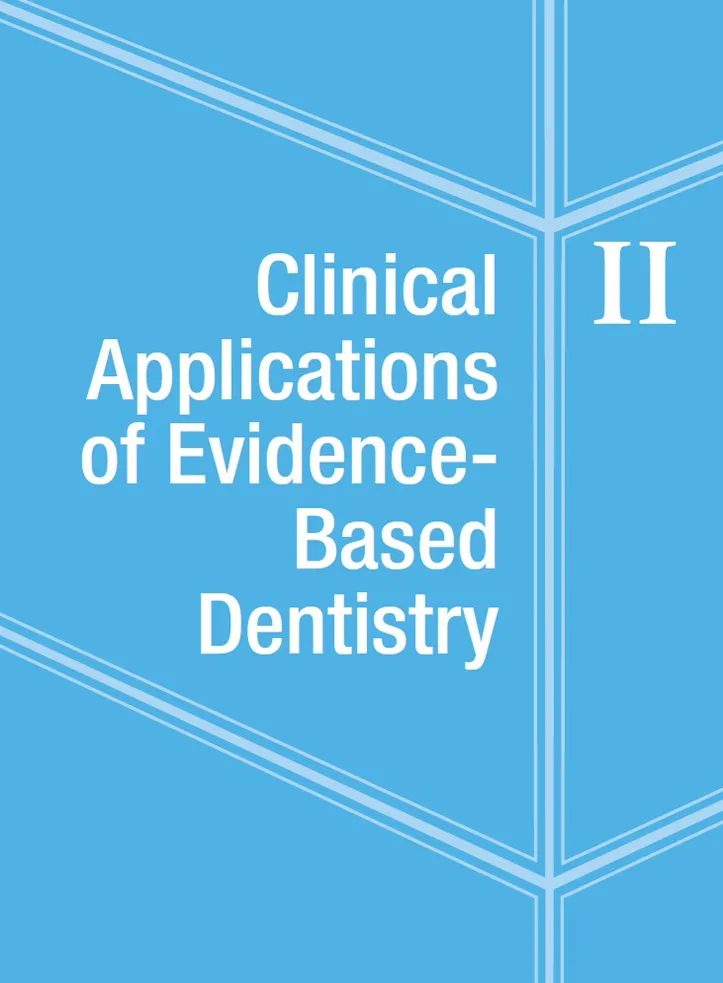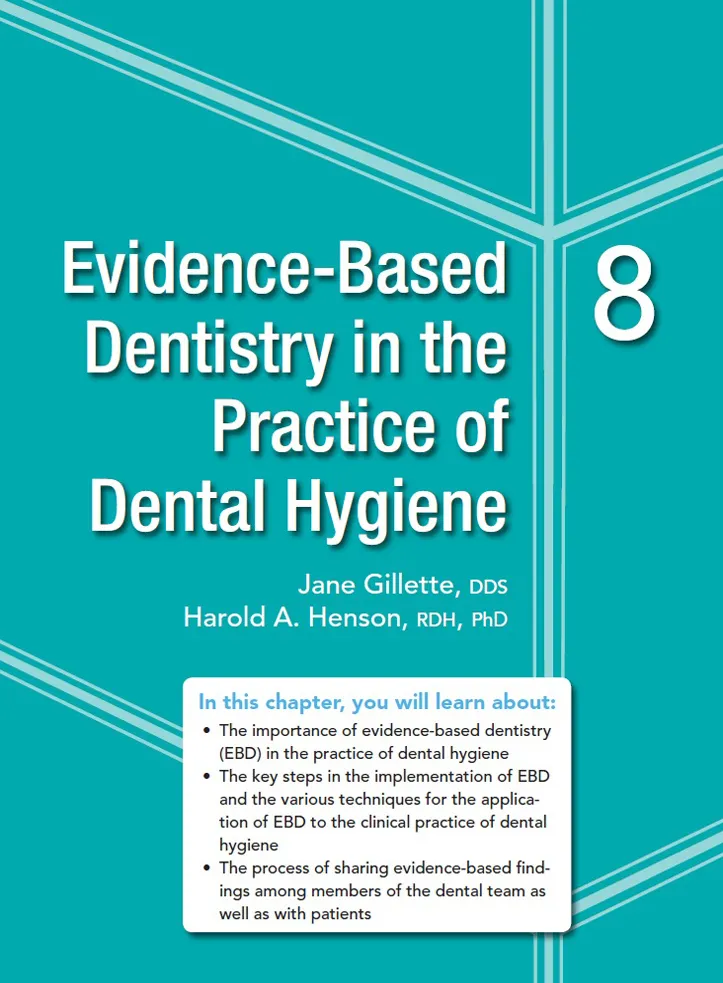
This is a test
- 376 pages
- English
- ePUB (mobile friendly)
- Available on iOS & Android
eBook - ePub
Evidence-Based Dentistry for the Dental Hygienist
Book details
Book preview
Table of contents
Citations
About This Book
Like any other dental professional, dental hygienists must practice evidence-based dentistry (EBD) to provide the best care to their patients, whether it be through scaling and root planing, caries prevention, or patient education. This book is intended as a textbook for dental hygienists to learn the importance of EBD in the practice of dental hygiene as well as how to implement EBD practices and share EBD findings among office staff. As the dental knowledge base evolves and scientific discoveries are made, dental hygienists must understand how to seek out and evaluate findings and, if appropriate, apply them in their clinical practice, and this book provides all the necessary tools to do just that.
Frequently asked questions
At the moment all of our mobile-responsive ePub books are available to download via the app. Most of our PDFs are also available to download and we're working on making the final remaining ones downloadable now. Learn more here.
Both plans give you full access to the library and all of Perlego’s features. The only differences are the price and subscription period: With the annual plan you’ll save around 30% compared to 12 months on the monthly plan.
We are an online textbook subscription service, where you can get access to an entire online library for less than the price of a single book per month. With over 1 million books across 1000+ topics, we’ve got you covered! Learn more here.
Look out for the read-aloud symbol on your next book to see if you can listen to it. The read-aloud tool reads text aloud for you, highlighting the text as it is being read. You can pause it, speed it up and slow it down. Learn more here.
Yes, you can access Evidence-Based Dentistry for the Dental Hygienist by Julie Frantsve-Hawley in PDF and/or ePUB format, as well as other popular books in Medicine & Dentistry. We have over one million books available in our catalogue for you to explore.
Information


The production of valid, clinically significant research is a major challenge in science because both researchers and clinicians may have strong cognitive barriers to acquiring unbiased information. Our understanding of the best available science changes with advancements in technologies and improvements in methodology and statistical methods. Consequently, practitioners may rely on inaccurate, outdated, or partial information and may be largely unaware of these discrepancies. Implementation of evidence-based approaches into clinical practice maximizes the application of valid, relevant, and unbiased evidence and minimizes the cognitive barriers to translating research into clinical care. Because of the increasingly rigorous ethical standards evolving within the profession, limited resources, and the changing emphasis on value in health care, there is a strong need to implement EBD into the practice of dental hygiene. Dental hygienists can implement EBD into their practice by becoming an EBD champion, creating an EBD learning environment, rating and sharing clinical evidence with others, and embedding EBD into workplace operational systems.
Importance of EBD for the Practice of Dental Hygiene
Dental hygienists play a fundamental role in educating patients on the importance of oral health care, and the science behind it so that patients can more fully participate in the management of their own oral health. Therefore, the practice of EBD in oral health care is greatly needed in order to provide patient-centered health care, which is defined as the delivery of personalized health care services within a framework that acknowledges an individual’s unique needs, desires, and challenges.1 Studies demonstrate that services delivered within this model result in better health outcomes because the delivered care is more collaborative with the patient and therefore more sensitive to his or her needs.2 This concept is also fundamental to EBD in that EBD requires respect for individual patient desires and circumstances. These variables are deemed as significant in the EBD process for the application of the best scientific evidence and clinician expertise.
However, health care practitioners and biomedical scientists may rely on outdated, invalid, or only partial scientific knowledge even within their own area of expertise.3 Making matters worse, practitioners often do not adequately assess their own deficiencies; those with the greatest knowledge gaps are usually the least able to self-identify those gaps in knowledge.4 There are many factors that influence a practitioner’s continued adherence to false ideas, including the publication of invalid research,5,6 the appeal of extending unquestioned authority to gurus within the profession,7 and the vast nature of the ever-changing scientific literature for clinicians to review. However, even if clinicians were able to identify their own gaps in knowledge and find the time to review the scientific literature, there are strong cognitive barriers to implementing newly acquired knowledge.
Cognitive dissonance refers to the discomfort a person feels when he or she is confronted with information that challenges a belief, opinion, or item of knowledge.8 The more the opposing information challenges a person’s self-concept (ie, a view of oneself as a competent professional, a good human being, and an ethical person), the greater the intensity of the internal conflict. The resulting discomfort is highly motivating, and individuals will undertake substantial effort to relieve the tension they feel, including engaging in significant ego preservation by reframing and discounting the opposing information (Fig 8-1). This process of self-justification occurs below the level of the conscious mind.9 Nevertheless, indicators of this process can be witnessed in health care in practitioners’ refusal to accept new scientific evidence that discredits their current practice and their tendency to seek only information and cues that confirm their own beliefs (known as confirmation bias), among other biases that impact both practitioners and researchers.

Fig 8-1 Cognitive dissonance.
When conducting scientific studies, researchers make multiple decisions, such as which variables to include, when to stop collecting data, which comparisons to make and statistical analysis to use, and how study results are presented. These choices, along with researcher bias, can strongly impact the outcomes of studies, leading to false-positive study results. This flexibility in study methodology, influenced strongly by aspects of cognitive dissonance and confirmation bias, is referred to as researcher degrees of freedom and allows for the presenting of almost any study finding as significant10 (Fig 8-2).

Fig 8-2 Researcher degrees of freedom.10
There is great urgency for practitioners to utilize the EBD approach to care, which maximizes the use of valid evidence with minimal biases and minimizes the natural tendency toward cognitive dissonance and confirmation bias. In fact, within health care and the profession of dental hygiene, there is an ethical obligation to “do no harm,”11 and adverse events or suboptimal treatment outcomes can ensue when the best available evidence is not applied. Multiple examples of the acute and lesser consequences of the application of discredited evidence can be seen in both medicine and dentistry. In the treatment of breast cancer, the radical mastectomy was the standard of care for an extended period of time past the appearance of strong evidence demonstrating the comparable effectiveness of lumpectomies.12 Contrary to the precautionary principle—the theory that if the effects of a product or action are unknown, then the product should not be used or the action should not be taken—for routine dental extractions, it is traditional practice to interrupt anticoagulation therapy despite insufficient evidence of benefits of the practice and some evidence of harm, including potential death.13 A less acute, however extremely significant, consequence of applying outdated evidence is the underuse of dental sealants despite abundant and strong evidence of the intervention’s effectiveness in preventing tooth decay.14 These examples and many others convincingly portray the potential harm of the application of invalid scientific evidence on both the human level and the societal level.
Additionally, in an ever-competitive private market and in light of major changes in the US health care delivery system, there is an increasing focus on the pragmatic management of health care services.15 Value in health care (health outcomes per dollar spent) has become the central focus of health organizations and clinicians alike, who collectively support improvements in health results balanced by the cost of delivering that care. Topics of effectiveness and cost relevant to value-based health care include the following16:
• Cost per patient over the entire care cycle of a disease
• Operational systems efficiency (ie, the capability of a organization to deliver products or services to its customers [patients] in the most cost-effective manner possible while still ensuring the high quality of its products, service, and support)
• Chair time per service delivered
• Scope of services provided
• Comparative effectiveness of interventions (ie, comparing the results of one approach for managing a disease to the results of other approaches)
• Health results per dollar spe...
Table of contents
- COVER PAGE
- TITLE PAGE
- COPYRIGHT PAGE
- CONTENTS
- PREFACE
- CONTRIBUTORS
- I: FINDING AND EVALUATING EVIDENCE
- II: CLINICAL APPLICATIONS OF EVIDENCE-BASED DENTISTRY
- ANSWERS TO REVIEW QUESTIONS
- GLOSSARY